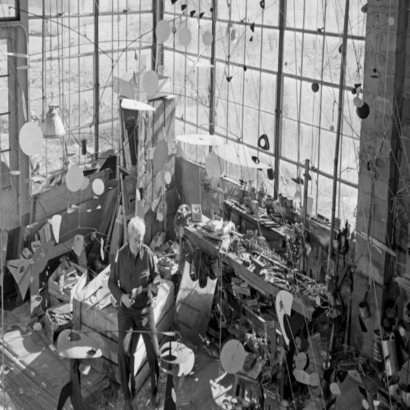Alexander Calder, from monumental sculptures to jewelry
Calder was born on July 22, 1898 into a family of artists. His father and grandfather were successful sculptors, his mother was a portrait artist, and his sister was involved in the development of the UC Berkeley Art Museum.
At an early age, Calder followed in his parents' (and grandfather's) footsteps and created works of art. From an early age, he showed a passion and great talent for sculpture. Fearing a financially uncertain future for their son, his parents encouraged him to study mechanical engineering. After graduating from Stevens Institute of Technology in 1919, Calder worked for several years as a hydraulic engineer and draftsman for the New York Edison Company. However, he was still obsessed with art and moved to New York to pursue a career as an artist.
In 1926, he moved to Paris to study art more seriously. During this time he became friends with avant-garde artists including Marcel Duchamp, Fernand Léger and Jean Arp. His first miniatures were created. They often consisted of mechanical toys, such as the famous Cirque Calder, a travelling circus made entirely of steel wire and recycled materials. These miniature mechanical toys were the beginning of his kinetic sculptures in steel wire.
In 1933, he returned to the United States and created his first monumental sculptures, large-scale outdoor mobiles using the same techniques and materials as his smaller Parisian works.
In the 1950s, Calder began to focus fully on the production of monumental pieces. In the 1960s, he was regularly commissioned for public works. Today, his monumental sculptures can still be seen in public spaces around the world, from Tel Aviv and Berlin to Montreal and Seattle.
With his kinetic mobiles, Calder reinvented sculpture and pushed the boundaries of the mobile work. Not surprisingly, his artistic philosophies are perfectly suited to jewelry. Georgia O'Keeffe and Peggy Guggenheim were among the celebrities who wore the artist's creations: earrings, bracelets, hair accessories, necklaces and brooches.
At the time, these modernist pieces were extremely unconventional. Made of silver wire or brass, the pieces are oversized and do not include precious materials or stones, attracting the attention of avant-garde designers looking for something new.
Spirals and zigzags, hammered and bent metal...all of Calder's pieces are unique and handcrafted, often created with a specific wearer in mind, as many of his brooches feature initials or names.
Innovative, Calder never uses solder: all fasteners and fittings are made of bent silver, brass or occasionally gold, but Calder has always preferred non-precious materials.
In 1972, George Stanley Gordon of the advertising agency Gordon & Shortt offered Calder the opportunity to paint a plane. Fascinated by the idea of turning the plane into the world's largest flying work of art, he accepted. The following year, an airliner for Braniff South American Airlines called Flying Colours of the United States was painted in Calder colors.
n 1974, French auctioneer and racer Hervé Poulain asked Calder to paint the car he would drive in the 24 Hours of Le Mans that same year. Upon the artist's death in 1976, the customized BMW 3.0 CSL became one of his very last works.
Calder is the first to submit to the exercise of dressing the BMW Art Car of Hervé Poulain. For this he uses a palette of primary colors that characterizes the whole of his work. "I want to make things that are fun to look at, that have no propaganda value," explains Alexander Calder in Conversations with Artists (New York, 1957).
Frank Stella, Roy Lichtenstein, Andy Warhol, David Hockney, Jenny Holzer, Jeff Koons have all created their own versions of this very special BMW.
In 1976, Calder attended the 24 Hours of Le Mans to see Sam Posey, Jean Guichet and Hervé Poulain compete. After seven hours of racing, the car was withdrawn from the race due to damage.
At auction, Calder's works sell for millions. His current record is held by the 1957 work Flying Fish, which went for $26 million (€18.6 million) at Christie's in May 2014.
While Calder is best known for his kinetic sculptures, he transcended the discipline. His creations in transportation, goldsmithing, miniatures and monumental sculptures attest to this.
Translated with www.DeepL.com/Translator (free version)


